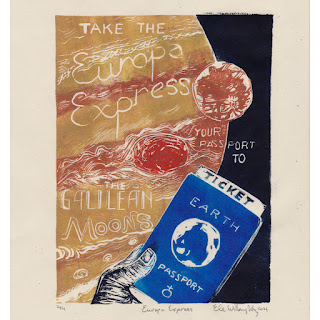Green Tea Chemistry linocut by Ele Willoughby
I thought I should add a tea chemistry linocut to go with the coffee linocut, which includes the caffeine molecule. Of course, tea chemistry is quite complex! I asked on Twitter, thinking I might have some tea loving scientist followers with good suggestions and I wasn't disappointed. Not only was I given some good feedback about which chemicals to feature, but also the suggestion of including the chromotography, as a means of telling the fuller chemical story.
There's a tea pot, two cups of tea and a tea plant (Camellia sinensis) on a tray, and in the steam, you can see some of the organic chemicals found in green tea. Up to 27% of the composition of green tea can be a member of the flavonoids called catechins like the molecule illustrated on the right. The stimulating effect of green tea is of course related to caffeine (the molecule in the middle) but, unlike say coffee, green tea also has an amino acid in tea called L-Theanine (the molecule on within the tea pot handle). L-Theanine has a direct effect on the brain, relaxing it without making you drowsy and can help with focus and mood; it's also largely responsible for taste. Since the chemistry of green tea is complex, and I can't show all the molecules involved, at the base of the tray is a chromatogram to illustate the L-Theanine (largest peak) and other amino acids in the green tea.
With tea and teapots on the brain, I started thinking about a suggestion for another "imaginary friend" of science (my collection of charismatic thought experiments like Maxwell's Demon or Schroedinger's cat): Russell's Teapot.
Russell's Teapot by Ele Willoughby
The alledged china teapot, in orbit between Earth and Mars
is an analogy by philosopher Bertrand Russell (1872–1970) to make the
case that the philosophic burden of proof lies upon a person making
unfalsifiable claims, rather than shifting the burden of disproof to
others. The print is made by hand on lovely 8" x 9" (20.3 cm x 22.9 cm)
Japanese Obonai paper with a feathery sheen.
The Earth appears
in blue in the corner. The China teapot itself has a blue flower
pattern, and is shown magnified. Mars is in red with two tiny moons. At
the bottom are the symbols for the solar system: Sun, Mercury, Venus,
Earth, and the extra teapot, Mars, Jupiter, Saturn, Uranus and Neptune.
I also made a couple of Snowy Owl light boxes, which include my snowy owl linocut and colour changing LEDs to simulate the aurora.
While, we've been on a lockdown here in Toronto, and the schools are closed, so I'm spending a lot of time every day fascillitating online school for my 7 year old, I have also been trying to do all of the Printer Solstice prompts (one a week since the winter solstice).
Humpback linocut for prompt "under pressure".















No comments:
Post a Comment